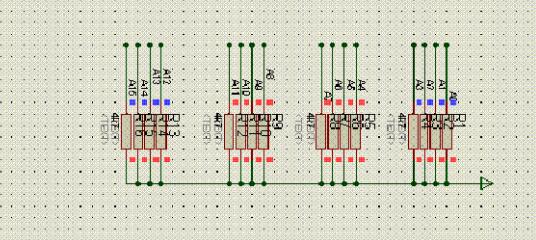74HC165的级联电路图

74HC165是一款高速CMOS器件,74HC165遵循JEDEC标准no.7A。74HC165引脚兼容低功耗肖特基TTL(LSTTL)系列。
74HC165是8位并行读取或串行输入移位寄存器,可在末级得到互斥的串行输出(Q7和Q7),当并行读取(PL)输入为低时,从D0到D7口输入的并行数据将被异步地读取进寄存器内。
而当PL为高时,数据将从DS输入端串行进入寄存器,在每个时钟脉冲的上升沿向右移动一位(Q0→Q1→Q2,等等)。利用这种特性,只要把Q7输出绑定到下一级的DS输入,即可实现并转串扩展。
74HC165的时钟输入是一个“门控或”结构,允许其中一个输入端作为低有效时钟使能(CE)输入。CP和CE的引脚分配是独立的并且在必要时,为了布线的方便可以互换。只有在CP为高时,才允许CE由低转高。在PL上升沿来临之前,不论是CP还是CE,都应当置高,以防止数据在PL的活动状态发生位移。
74HC165是一种并入串出的芯片,我们可以用它来做按键检测。它可以外接8个接键,然后将数据转成串行的送入单片机。如果用74HC165做键盘的话,能节省很多IO口。
74hc165使用方法与级联程序


LCD程序是采用wang1jin带您从零学单片机里面的1602程序修改。
#include《AT89X52.H》
#include“LCD.h”
#defineuint16unsignedint
#defineuint8unsignedchar
#defineAUDIO_OUTP0
///////////////////////////////////////////////////////
sbitHC165_CE=P1^1;//HC165控制端L有效
sbitHC165_PL=P1^2;//HC165锁存引脚H高效
sbitHC165_CLK=P1^0;//HC165时钟引脚
sbitHC165_IN=P1^3;//HC165数据输出引脚
uint8Address=0;//本地地址变量
uint8Priority=0;//优先级变量
///////////////////////////////////////////////////////
uint8LCD_DATA1[]={
‘0’,‘1’,‘2’,‘3’,‘4’,‘5’,‘6’,‘7’,‘8’,‘9’,‘A’,‘B’,‘C’,‘D’,‘E’,‘F’
};
voidInit_INT(void);
voidRead_HC165(void);
voidmain(void){
Init_INT();LCD1602();
Init_Lcd();while(1){
Read_HC165();
Display_LCD_Byte(0,0,‘0’);
Display_LCD_Byte(0,1,‘x’);
Display_LCD_Byte(0,2,LCD_DATA1[Address/16]);
Display_LCD_Byte(0,3,LCD_DATA1[Address%16]);
Display_LCD_Byte(1,0,‘0’);
Display_LCD_Byte(1,1,‘x’);
Display_LCD_Byte(1,2,LCD_DATA1[Priority/16]);
Display_LCD_Byte(1,3,LCD_DATA1[Priority%16]);
}
}
////////////////////////////////////////////////定时器初始化
//////////////////////////////////////////////voidInit_INT(void)
{
TMOD=0x01;
ET0=1;
TR0=1;
EA=1;
TH0=0xF8;
TL0=0xC5;
}
//////////////////////////////////////////////
//读取优先级和本机地址
//当执行本次程序时
//函数会将165的信号优先级
//以及本机的地址送到Priority和Address
//////////////////////////////////////////////
voidRead_HC165(void)
{
uint8i=0;//临时变量
uint8BJ_Address=0;
uint8BJ_Priority=0;
HC165_CE=0;//打开165选通端
HC165_PL=0;//允许数据进入165
for(i=0;i《8;i++)//读8次数据
{
HC165_PL=1;//允许数据移位
HC165_CLK=0;//低电平时读取数据
if(HC165_IN)//数据高位在前
{
BJ_Priority|=0x80》》i;
}
HC165_CLK=1;//数据移位
}
for(i=0;i《8;i++)//读取下一个165的数据
{
HC165_CLK=0;
if(HC165_IN)
{
BJ_Address|=0x80》》i;
}
HC165_CLK=1;
}
HC165_CE=1;
HC165_PL=0;
Address=BJ_Address;
Priority=BJ_Priority;
}
#ifndef_LCD_H_
#define_LCD_H_
#include《AT89X52.H》
#defineLCD_DATAP3
sbitRS=P1^5;
sbitRW=P1^6;
sbitEN=P1^7;
voidLCD1602(void);
voidRead_Busy(void);
voidWrite_Lcd(unsignedcharValue,biti);voidInit_Lcd(void);
voidDelay(unsignedinti);
voidDisplay_LCD_Byte(unsignedchary,unsignedcharx,unsignedcharValue);
#endif
#include“LCD.h”
voidLCD1602(void)
{
EN=0;
RS=1;
RW=1;
LCD_DATA=0xFF;
}
voidRead_Busy(void)
{
LCD_DATA=0xFF;
RS=0;
RW=1;
EN=1;
//while(LCD_DATA&0x80);
Delay(100);
EN=0;}
voidWrite_Lcd(unsignedcharValue,biti)//i=0写指令.i=1写数据;
{
Read_Busy();
LCD_DATA=Value;
RS=i;RW=0;
EN=1;
EN=0;
}
voidInit_Lcd(void)
{
Delay(15000);
Write_Lcd(0x38,0);
Delay(5000);
Write_Lcd(0x38,0);
Delay(5000);
Write_Lcd(0x38,0);
Write_Lcd(0x08,0);
Write_Lcd(0x01,0);
Write_Lcd(0x06,0);
Write_Lcd(0x0c,0);
}
voidDisplay_LCD_Byte(unsignedchar
y,unsignedcharx,unsignedcharValue)
{
y&=0x01;//y不能大于1x&=0x0F;//x不能大于15
if(y)//是否显示在第二行;
{
x+=0x40;//显示在第二行,加0X40;
}
x+=0x80;
Write_Lcd(x,0);//写入显示的位置
Write_Lcd(Value,1);//写入显示数据}
voidDelay(unsignedinti)
{
while(--i);
}
 电子发烧友App
电子发烧友App



































评论